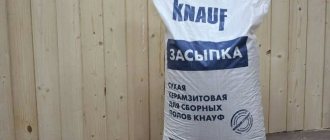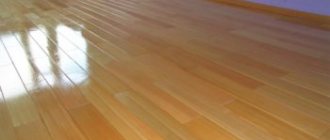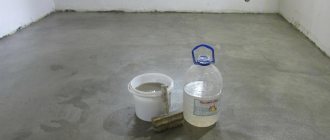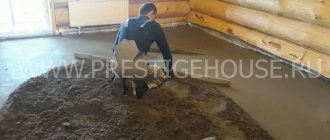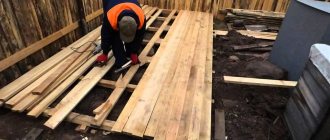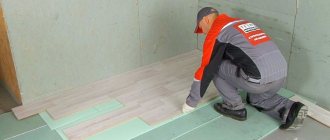The technology of semi-dry floor screed largely repeats the well-known techniques of pouring a floor with concrete or cement-sand mortar. It can be used to level a rough base, form a foundation slab from it, and after sanding it can serve as an industrial floor. But since the formula of the mixture is somewhat modified compared to the usual one, this led to an adjustment in the technological principles of pouring. It will be important to understand what the main differences between the modernized method and the traditional one are, as well as why home craftsmen and professional builders liked it.
What is a semi-dry screed? Its pros and cons
The expression “semi-dry screed” quite eloquently explains the essence: here significantly less water is added to the solution. When such a solution is prepared, exactly as much water is added to it as is required to hydrate the cement, that is, so that the molecules form strong crystalline bonds.
Advantages of semi-dry screed
A mixture devoid of excess moisture, which turns into stone as a result of the hardening process, becomes not only lighter, but also less labor-intensive to use. It also has other advantages:
- Higher density, which allows you to increase the strength of a construction object or structural element. Since, during the preparation of the mixture, excess water does not enter it, which is excessive for the hydration of cement, the subsequent long process of its evaporation will not be observed, and at the same time the appearance of pores, cavities and voids. And the fewer pores there are in the monolith, the stronger it will be.
- The absence of pores in the hardening mass also leads to the absence of shrinkage.
- The absence of the process of evaporation of excess moisture greatly accelerates the rate of maturation of the screed.
- When a semi-dry screed is used, the technology for its use turns out to be much cleaner than the traditional one - without dampness and sticky dirt.
- When working with a semi-dry screed, the humidity in the room does not increase, which allows you to simultaneously carry out finishing work here.
You can walk on a semi-dry screed within 12 hours after its formation, and in order to do finishing work in this room (except for laying the topcoat), it will be enough to wait only one day. It will also be possible to begin final finishing of the floor surface much earlier than with traditional technologies.
Disadvantages of semi-dry screed
Of course, semi-dry floor screed also has disadvantages:
- The thickness of the screed brings not only advantages, but also disadvantages: the material does not spread well, which is why it is difficult to form clear angles in places where walls meet the floor or between each other; instead, rather smooth transitions are obtained.
- The difficulty of manual work with semi-dry screed when it comes to fairly large areas (more than 75 sq. m.).
- It is impossible to use a layer thinner than 3 cm; the optimal value for it is 4-5 cm.
When a semi-dry screed is used, they try to correct its shortcomings using various tricks. For example, excess thickness is compensated by adding plasticizers. A clear dividing line in the corners is obtained in the most primitive way - immediately after laying the leveling mass, it is tamped.
Features of the technological process
Its fundamental difference is the most accurate dosage of water in the concrete solution, ensuring hydration of the cement in the mixture and not remaining free in the concrete stone.
The purpose of installing a leveling screed in this form is to reduce construction or repair time by minimizing the drying time of the laid layer.
Great option for home and apartment
This type of screed has many advantages, but the main one is that you don’t have to wait long for the solution to dry completely. Unlike “wet” screed, semi-dry screed is ready for use almost immediately.
The peculiarity of installation is the need to control the density of installation in places where the screed adjoins walls and lighthouses, where the mixture is prone to the formation of voids due to reduced ductility. An additional technological technique to avoid this effect is the introduction of a special composition into the mixture - a plasticizer, which increases the fluidity of the solution. An indication of this on the packaging of the dry mixture or in the recipe for preparing the composition yourself will help you choose the right additive.
Semi-dry screed thickness
Since the leveling mass contains almost no free water, it hardens at an accelerated pace. If the thickness of the screed is too small, it will dry before it adheres to the base material. As a result, it will peel off from the base and crumble quite quickly under the influence of feet stepping on it. On the other hand, a thick (5-7 cm) screed will be too heavy, because every centimeter of its thickness will add 90-120 kg of weight per square meter of floor. Therefore, if the task is to raise the floor, then first you need to pour a layer of expanded clay on the base or fill it with expanded clay concrete, and only then use the mixture for a semi-dry screed.
The thickness of the semi-dry screed is limited to a fairly narrow frame (4-5 cm).
Therefore, the design of its structure is predetermined - a floating floor, which is not attached to either the base or the walls. It is rational to separate such a screed from the subfloor with a layer of waterproofing, and separate it from the walls along the entire perimeter of the room with expanded polystyrene tape, which also serves as sound insulation. But thanks to the floating structure, such a screed will not be subject to stresses that arise when it catches on the walls and can break it.
Kinds
Depending on the technology and materials used, screed can be divided into several types.
According to the coupling method:
- connected;
- floating;
- separate;
By installation method:
- self-leveling;
- solid;
- national team;
- semi-dry;
According to the material used:
- plaster;
- cement-sand;
- semi-dry with fiber fiber;
- industrial;
- screed with plasticizers.
To create a level base, leveling and combined solutions are used. A small layer is laid, which creates a flat floor for further finishing. Combined technologies include leveling the base and installing thermal insulation.
Reinforcement of semi-dry screed
To prevent cracks from appearing in a semi-dry screed, fiber is added to it, which is increasingly displacing conventional reinforcing mesh from the screed preparation technology. There are several reasons for this:
- it is much easier to mix fiber fibers than to transport them to the site and spend a lot of time and effort on laying more expensive mesh reinforcement;
- thin threads of polypropylene are located chaotically in the hardening mass, and therefore bind the structure of the stone in all directions;
- the fibers prevent cracks from appearing in the monolith, while the mesh begins to resist once a crack has already occurred.
You can continue to use reinforcing mesh, but it will be less effective. Those home craftsmen who definitely want to use mesh reinforcement of semi-dry screed will have to go through three rather labor-intensive processes:
- Lay 2-3 cm of the base layer according to the classical rules.
- Lay out the reinforcing mesh on top, connecting its parts with wire.
- Cover the top of the reinforcement with two centimeters of the top leveling layer.
Surface preparation
- Carefully inspect the floor: tap with a hammer to find loose areas of cement, remove them using a hammer drill, and fill the resulting voids with cement mixture. Expand and restore cracks, knock down noticeable bulges.
- The interface lines between the floor and walls must be treated with cement mortar, even if there are no cracks in these places.
- After this, remove stains of oil paint and grease from the base and vacuum it thoroughly.
Actions after final drying
After the final hardening of the solution, it is polished with special graters and machines.
Immediately after filling , the holes and recesses from the beacons and screws are sealed with a ready-made solution , and then the maintenance is standard: wetting, grinding. When cracks appear, gaps, after the screed has matured, special mixtures are used to smooth them out, but we especially pay attention - only after final hardening.
You can turn on the heated floor, as well as use artificial drying, only after reaching the maximum hardening period - after 4 weeks.
Preparation of semi-dry mixture
First you need to calculate the semi-dry screed, and then purchase the following in the required quantities:
- Portland cement (preferably grade 400 D20);
- washed quarry or river sand;
- additives that improve the fluidity of the mixture.
It is recommended to rent a concrete mixer, otherwise you will have to do it the old fashioned way, using a trough, a shovel and a lot of physical labor.
The components for preparing the solution have their own requirements:
- Sand will be required with a fineness modulus of up to 2.5. The sand should contain no more than 3% of fine clay inclusions, and should be completely free of any random plant remains and peat veins. Natural humidity is allowed, which in practice can fluctuate over a wide range, so the amount of water added to the mixture may be different.
- You need to buy cement with an unexpired shelf life and in undamaged original packaging. If Portland cement 400 D20 is used, the result will be a solution corresponding to the M200 cement brand, and in the case of the original Portland cement 500 D20, the cement mixture will be M350, which can be used in places with difficult operating conditions.
- You cannot take water from untested reservoirs, as it may be contaminated with biological or technical waste. But tap water is fine.
Proportions of the dry mixture: 3 parts sand x 1 part cement x part water in the amount required for the given case.
- In the middle of the container for preparing the mixture, you need to build a slide, pouring in portions of 3 shovels of sand and 1 shovel of cement in the required quantity.
- Then mix all the components dry, and then begin to slowly pour in water with the fiber fiber added there.
- A semi-dry cement-sand screed should be diluted with water to the consistency of sandy loam - like clay sand that sticks together into a lump, but when compressed, no moisture is released, and the lump itself retains its given shape.
- Since the moisture content of the original sand can be different, water has to be added “by eye”, which often ends in overflow. If moisture begins to ooze from a lump of semi-dry solution, then you need to add the dry components to the mixture in the same proportions.
- Polypropylene fiber should be added to each bucket of water so that it disperses more easily through the mixture. Approximately 80 g of fiber is added to each bucket, but the manufacturer’s labeling indicates how much fiber fiber should be added per cubic meter of mixture.
- If a pneumatic machine is used for semi-dry screed, then with its help you should simultaneously prepare such an amount of semi-dry mixture that would be enough for the entire thickness of the screed. If the mixture is prepared manually, then it must be laid out in layers: first the lower part, followed by tamping, then the upper part, which is leveled by the rule and at the same time sanded.
The solution begins to lose the properties necessary for the leveling mass in an hour or even earlier, so you need to plan all operations in advance and work on the screed at an accelerated pace.
- Some craftsmen recommend starting to lay the mortar from the periphery, but this option is possible if the general leveling layer can then be applied in no longer than an hour. If this takes more time, the laid mixture will be covered with a hardened crust, resulting in an extra seam that will open the way for the penetration of cold.
Pouring semi-dry screed
- Cover the subfloor with waterproofing, roofing felt or polyethylene in such a way that the waterproofing strips form a kind of pallet with sides extending 15 cm onto the walls, and the strips themselves are laid with an overlap and then secured with tape.
- Secure polypropylene electrical tape vertically along the perimeter of the walls, which must first be cut into strips of suitable sizes. It is recommended to use isolon 10 cm wide and 8-10 mm thick.
- On the walls, you need to mark in advance the required height of the screed using a simple or laser level. After this, on top of the waterproofing, in accordance with the given level, it is necessary to build rail beacons from beds of mortar, on the ridges of which guide profiles should rest. Linear beacons must be positioned so that the rule rests on two adjacent rails, with 20-30 cm remaining between the guide and the wall.
- Then you need to spread the mixture with a shovel so that its level is below the level controlled by the beacons. The mixture must be compacted immediately (it is advisable to involve assistants for this).
- Place the semi-dry mixture on the compacted surface, but above the level of the beacons, after which the screed is simultaneously compacted and leveled.
- Immediately sand the formed screed.
- In rooms whose area exceeds 12-15 m2, after 24 hours it is necessary to cut expansion joints along the walls, the depth of which is a third of the leveling layer and the width is 3 mm.
- After this, the semi-dry cement screed should be covered with overlapping sheets of polyethylene and left for some time (from 1 day to 1 week, if the conditions for hardening are normal). In hot weather, the screed will have to be moistened with water for several days so that hardening proceeds normally, without the formation of cracks and deformations.
Video about semi-dry screed technology:
Comparison of characteristics
A comparative analysis makes it possible to understand in more depth the issues: which is better, a semi-dry screed or a classic screed and a dry screed or a cement screed. For comparison, let's take the following criteria:
- strength;
- cost of materials per m2 of screed;
- cost of work;
- durability;
- resistance to sudden changes in temperature and humidity;
- thermal conductivity;
- floor load;
- complexity of technology;
- surface quality level;
- screed thickness;
- compatibility with heated floors;
- application area.
Strength
One of the main criteria for evaluating a screed is its ability to withstand static and dynamic loads. After all, you can’t place a fireplace or heavy furniture made of solid wood on a floor that might fall through. In this regard, classical technology is the leader - it can withstand up to 20 MPa. The semi-dry screed is slightly inferior to it. But the data here is contradictory. Some sources consider its strength to be high, others - worse than dry. Long searches in various reference books (is it really a military secret) made it possible to find some numbers: from 1.0 to 18.0 MPa. But this cannot be.
A specific figure can be found if desired, but in a “crooked” way. It is known that the strength value is directly related to the density indicator. And these indicators are in the technical conclusion of one interesting work devoted to the study of the thermal conductivity of semi-dry unbound cement-sand mortar.
It indicates the average density of such a screed - 1450 kg/m3. The density of the leveling layer poured using “wet” technology is 1800 kg/m3. Then everything is simple: divide 1450 kg/m3 by 1800 kg/m3 and multiply by 20 MPa (strength of cement screed). As a result, we obtain a semi-dry screed strength of 16.1 MPa. A figure close to real strength. Reinforcing mesh and fiberglass slightly increase the performance. But their input is also possible in the “wet” CPR.
It was also not possible to find exact strength figures for dry screed - no one knows, no one needs it. But here everything is much simpler: just as the speed of the squadron depends on the speed of the slowest ship, so the strength of the screed is determined by the strength of one pellet: 2.0 MPa - average, 4.5 MPa - maximum.
Conclusion: in terms of strength, “wet” technology is the undoubted leader. Dry screed under a fireplace, stove, frame furniture made of solid precious wood will simply crumble. It won’t even support the weight of a car in the garage.
Cost of materials per 1 m2 of screed
When carrying out repairs, one of the main criteria is the cost of materials per 1 m2 of screed. And here we observe an interesting situation: the cheapest type of material is expanded clay. For 1 m3 you will have to pay about 2000 rubles, if you take it in bulk, without packaging. And many consumers buy into this.
In fact, 1 m2 of cement screed costs from 320 rubles. up to 397 rub. (calculations can be viewed here). A dry screed will be more expensive. Expanded clay itself will cost about 90 rubles/m2 plus flooring 280-300 rubles/m2 for one layer, but you need two.
Conclusion: despite the apparent cheapness of expanded clay, a screed made from it will cost more, and significantly. Cement screeds, despite the difference in the thickness of the mortar being laid, are completely equal, because the consumption of materials is the same, and the extra 1 cm in the thickness of the bond appears due to the lower density of the semi-dry technology.
Cost of work
You can order a professional team to install the screed:
- for dry - for 200 rub./m2;
- semi-dry - 250 rub./m2;
- “wet” - from 400 rub./m2.
These are reasonable prices for proven teams. There are also smaller ones. For example, they are ready to work using wet technology for 140-160 rubles/m2. But here the question immediately arises: why does the master not value his work? Most likely, such prices are offered by guests from Central Asia. There are also mind-blowing prices - 500-600 rubles / m2, designed for people who do not understand construction at all.
Conclusion: dry screed is the cheapest option. The most expensive is the classical method.
Durability
In the absence of extreme operating conditions, all compared types of ties have approximately the same service life.
Conclusion: no one has an advantage in terms of operational life.
Resistance to temperature and humidity changes
Expanded clay actively absorbs moisture from the air and then dries for months - this is its peculiarity. Wet screed is the enemy of laminate flooring. In addition, due to the dampness of the leveling layer, there is a high probability of fungus and mold appearing on the walls. Therefore, expanded clay is not used in wet rooms.
Cement-based screeds do not absorb water, so the technology has no restrictions on humidity. Temperature changes do not affect the ceramic pellets in any way, and the screed changes its size. A damper tape around the perimeter of the walls solves the problem.
Conclusion: it is better to avoid using dry screed in wet rooms.
Thermal conductivity
When analyzing the thermal conductivity of screeds, several important points must be taken into account.
- In what quality do the owners of the home want to see the screed? If in the form of an additional insulating layer, then the advantage is given to the technology in which the screed conducts heat poorly (the thermal conductivity coefficient is lower). If in combination with a “warm floor”, then the opposite is true, good thermal conductivity is needed.
- Expanded clay is not friendly, in general, to heated floor coverings from below.
- Through a layer of expanded clay backfill up to 5 cm thick (some experts say up to 6 cm), heat escapes like sand through your fingers. This must be taken into account, especially when installing floors on the first floors of apartments and in private housing construction.
If we talk about specific numbers, the thermal conductivity coefficient is equal to:
- for a “wet” screed - 0.6-0.9 W/m*K;
- semi-dry - 0.45-0.46 W/m*K (when used in a dry state or in laboratory conditions - 0.4 W/m*K);
- dry - 0.16-0.18 W/m*K (depending on bulk density).
conclusions based on the above figures :
- for “warm floors” it is better to use “wet” technology - denser material will better transfer heat from the heating system to the floor covering. But you can’t refuse semi-dry pouring. With good thermal insulation from below, the heat will not go anywhere - it will remain in the room. The only trouble is that it takes longer to warm up the room when starting the heating system;
- Only expanded clay can really insulate a floor, but provided that the thickness of the screed is at least 5 (6) cm. Some visitors may argue that there is a contradiction: the materials on insulation say that the effect of heat preservation with expanded clay occurs only with a backfill layer of at least 20 cm. That's right. But in the case of a screed, there is another factor that insulation does not have - flooring, which prevents the circulation of cold air between the expanded clay granules.
Floor load
The weight of the leveling layer is important for weak floors: subfloors made of boards and floor slabs with a long period of operation. According to this criterion, at first glance, expanded clay is the undoubted leader with its specific gravity of 560-780 kg/m3. In second place is semi-dry screed - 1450 kg/m3. The heaviest weight of concrete is 1800 kg/m3.
But this is only at first glance. In reality, it's not that simple. So, a 1 cm thicker layer of semi-dry screed puts pressure on the ceiling in the same way as concrete. There is complete equality here. Expanded clay is lighter, even when the thickness of the screed is doubled.
Conclusion: on weak floors there is no alternative to expanded clay.
Complexity of technology
The easiest way is to fill expanded clay. Can be done well by a novice builder. A “wet” screed is more technologically complex and labor intensive.
It is believed that semi-dry screed should be done by professionals - you cannot fill it without a little mechanization. But it is not so. The work can also be done by a home handyman. How? Read here.
Conclusion: the most complex technology for screeding is the semi-dry unbound CPR method, the simplest is the dry method.
Surface quality level
According to the criterion of surface quality, there are two leaders: semi-dry technology, which, after grouting the laid mortar, has a smooth surface and a dry one, thanks to plywood or OSB flooring.
With the “wet” method, the difference in height can reach 5-7 mm due to uneven shrinkage. Therefore, an additional finishing operation is required: grinding or pouring a self-leveling mixture.
Conclusion: you can immediately get a smooth surface using dry and semi-dry screeding methods. “Wet” technology requires refinement, which means additional costs.
Screed thickness
In Khrushchev buildings, the thickness of the screed is one of the important indicators - you can take a couple of extra centimeters from a ceiling with a height of 2.3 to 2.7 m. But reducing the height of the ceiling, firstly, negatively affects the human psyche, and secondly, all interior doors will have to be cut.
The thinnest screed for the “wet” technology is 3 cm, 1 cm more for a semi-dry screed. For some reason, it is believed that dry screed is 4 cm. But this is not so. 4 cm is only the minimum thickness of poured expanded clay or vermiculite. You also need to lay flooring on top of the backfill. This is plus more than 3.5 cm. The result is 7-8 cm.
Conclusion: the thinnest screed is with the “wet” technology, the thickest with the dry one.
Compatibility with heated floors
In private construction, when choosing a technology for leveling the base of the floor, its compatibility with “warm floors” plays an increasingly important role. Here the expanded clay immediately disappears - inside the backfill, the water heating pipes or IR film will simply be crushed. Cement mortars do not have this problem. Another plus in favor of a “warm floor” inside concrete is the approximately equal expansion coefficient of most pipes and concrete screed when heated.
Conclusion: wet and semi-dry screeds are completely, without restrictions, compatible with heated floors. Dry - no.
Application area
A dry screed has a weak point - moisture. Therefore, restrictions are imposed for use in the bathroom, open balcony or loggia, basement, garage. The fragility of the concrete slab does not allow it to be laid on unstable foundations (soil), and its weight does not allow it to be laid on weak floors. Semi-dry technology has practically no limitations. An exception is a weak reason. May not be able to withstand the load.
Conclusion: semi-dry technology has a wider range of applications, while backfill has the smallest range of applications.
How long does it take for a semi-dry screed to dry?
Since a semi-dry screed does not shrink the surface, its grouting can be done immediately after leveling according to the rule. After this, you need to wait until the screed is completely dry. The advantage of the new technique is that after just 12 hours you can walk on the freshly prepared floor, and after the same amount of time, you can safely continue further finishing work in the room. It will also be possible to begin laying the final floor covering much earlier than was permissible with the old pouring technology.
However, there are some nuances here too. Although the technology of semi-dry floor screed is considered a modernization, it is also imperfect, so not all work after it can be started at the same time. It all depends on the properties that certain floor coverings have:
- tiles or porcelain stoneware that are not afraid of moisture can be laid already 2 days later;
- linoleum flooring will be possible in 1 week;
- but the installation of laminate or parquet can only be done a month later - and this is already the same period as for a standard cement-sand filling.
Would you use a semi-dry screed to level the floor? Maybe you already had experience working with it? Tell us about your experience and impressions in the comments - other readers will be interested!

